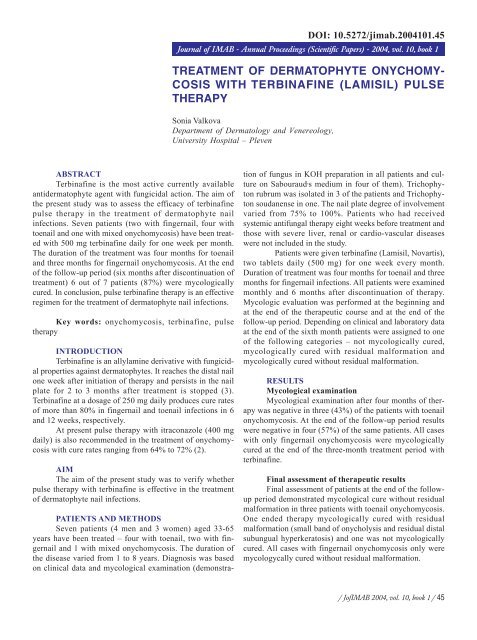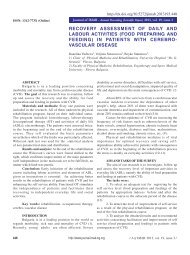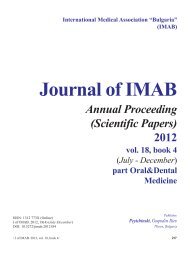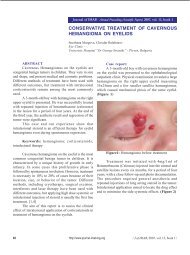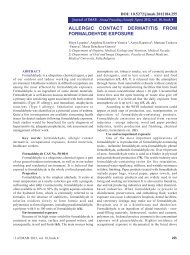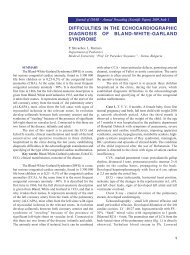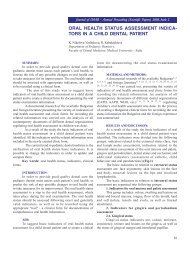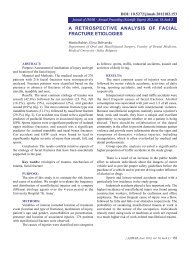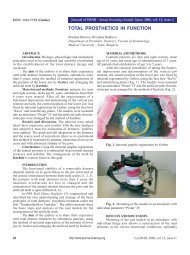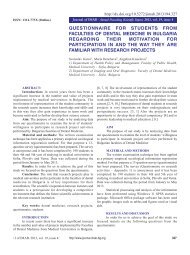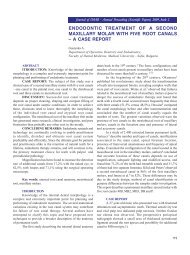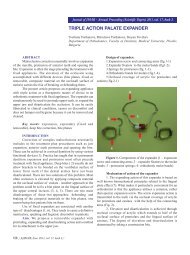TREATMENT OF DERMATOPHYTE ONYCHOMY ... - Journal of IMAB
TREATMENT OF DERMATOPHYTE ONYCHOMY ... - Journal of IMAB
TREATMENT OF DERMATOPHYTE ONYCHOMY ... - Journal of IMAB
You also want an ePaper? Increase the reach of your titles
YUMPU automatically turns print PDFs into web optimized ePapers that Google loves.
DOI: 10.5272/jimab.2004101.45<br />
<strong>Journal</strong> <strong>of</strong> <strong>IMAB</strong> - Annual Proceedings (Scientific Papers) - 2004, vol. 10, book 1<br />
<strong>TREATMENT</strong> <strong>OF</strong> <strong>DERMATOPHYTE</strong> <strong>ONYCHOMY</strong>-<br />
COSIS WITH TERBINAFINE (LAMISIL) PULSE<br />
THERAPY<br />
Sonia Valkova<br />
Department <strong>of</strong> Dermatology and Venereology,<br />
University Hospital – Pleven<br />
ABSTRACT<br />
Terbinafine is the most active currently available<br />
antidermatophyte agent with fungicidal action. The aim <strong>of</strong><br />
the present study was to assess the efficacy <strong>of</strong> terbinafine<br />
pulse therapy in the treatment <strong>of</strong> dermatophyte nail<br />
infections. Seven patients (two with fingernail, four with<br />
toenail and one with mixed onychomycosis) have been treated<br />
with 500 mg terbinafine daily for one week per month.<br />
The duration <strong>of</strong> the treatment was four months for toenail<br />
and three months for fingernail onychomycosis. At the end<br />
<strong>of</strong> the follow-up period (six months after discontinuation <strong>of</strong><br />
treatment) 6 out <strong>of</strong> 7 patients (87%) were mycologically<br />
cured. In conclusion, pulse terbinafine therapy is an effective<br />
regimen for the treatment <strong>of</strong> dermatophyte nail infections.<br />
Key words: onychomycosis, terbinafine, pulse<br />
therapy<br />
INTRODUCTION<br />
Terbinafine is an allylamine derivative with fungicidal<br />
properties against dermatophytes. It reaches the distal nail<br />
one week after initiation <strong>of</strong> therapy and persists in the nail<br />
plate for 2 to 3 months after treatment is stopped (3).<br />
Terbinafine at a dosage <strong>of</strong> 250 mg daily produces cure rates<br />
<strong>of</strong> more than 80% in fingernail and toenail infections in 6<br />
and 12 weeks, respectively.<br />
At present pulse therapy with itraconazole (400 mg<br />
daily) is also recommended in the treatment <strong>of</strong> onychomycosis<br />
with cure rates ranging from 64% to 72% (2).<br />
AIM<br />
The aim <strong>of</strong> the present study was to verify whether<br />
pulse therapy with terbinafine is effective in the treatment<br />
<strong>of</strong> dermatophyte nail infections.<br />
PATIENTS AND METHODS<br />
Seven patients (4 men and 3 women) aged 33-65<br />
years have been treated – four with toenail, two with fingernail<br />
and 1 with mixed onychomycosis. The duration <strong>of</strong><br />
the disease varied from 1 to 8 years. Diagnosis was based<br />
on clinical data and mycological examination (demonstration<br />
<strong>of</strong> fungus in KOH preparation in all patients and culture<br />
on Sabouraud , s medium in four <strong>of</strong> them). Trichophyton<br />
rubrum was isolated in 3 <strong>of</strong> the patients and Trichophyton<br />
soudanense in one. The nail plate degree <strong>of</strong> involvement<br />
varied from 75% to 100%. Patients who had received<br />
systemic antifungal therapy eight weeks before treatment and<br />
those with severe liver, renal or cardio-vascular diseases<br />
were not included in the study.<br />
Patients were given terbinafine (Lamisil, Novartis),<br />
two tablets daily (500 mg) for one week every month.<br />
Duration <strong>of</strong> treatment was four months for toenail and three<br />
months for fingernail infections. All patients were examined<br />
monthly and 6 months after discontinuation <strong>of</strong> therapy.<br />
Mycologic evaluation was performed at the beginning and<br />
at the end <strong>of</strong> the therapeutic course and at the end <strong>of</strong> the<br />
follow-up period. Depending on clinical and laboratory data<br />
at the end <strong>of</strong> the sixth month patients were assigned to one<br />
<strong>of</strong> the following categories – not mycologically cured,<br />
mycologically cured with residual malformation and<br />
mycologically cured without residual malformation.<br />
RESULTS<br />
Mycological examination<br />
Mycological examination after four months <strong>of</strong> therapy<br />
was negative in three (43%) <strong>of</strong> the patients with toenail<br />
onychomycosis. At the end <strong>of</strong> the follow-up period results<br />
were negative in four (57%) <strong>of</strong> the same patients. All cases<br />
with only fingernail onychomycosis were mycologically<br />
cured at the end <strong>of</strong> the three-month treatment period with<br />
terbinafine.<br />
Final assessment <strong>of</strong> therapeutic results<br />
Final assessment <strong>of</strong> patients at the end <strong>of</strong> the followup<br />
period demonstrated mycological cure without residual<br />
malformation in three patients with toenail onychomycosis.<br />
One ended therapy mycologically cured with residual<br />
malformation (small band <strong>of</strong> onycholysis and residual distal<br />
subungual hyperkeratosis) and one was not mycologically<br />
cured. All cases with fingernail onychomycosis only were<br />
mycologycally cured without residual malformation.<br />
/ J<strong>of</strong><strong>IMAB</strong> 2004, vol. 10, book 1 / 45
Tolerability<br />
Drug-related adverse effects were reported from one<br />
patient only – moderately strong itch. It was successfully<br />
infuenced by antihistamines and did not necessitate<br />
interruption <strong>of</strong> therapy.<br />
DISCUSSION<br />
Terbinafine (Lamisil) is an allylamine that inhibits the<br />
enzyme squalene-epoxidase, thus blocking the conversion <strong>of</strong><br />
squalene to squalene epoxide in the biosynthesis pathway<br />
<strong>of</strong> ergosterol, an integral component <strong>of</strong> the fungal cell wall.<br />
Its action results in both a depletion <strong>of</strong> ergosterol, which has<br />
a fungistatic effect, together with an accumulation <strong>of</strong><br />
squalene, which appears to be directly fungicidal. The<br />
minimum inhibitory concentration <strong>of</strong> terbinafine is very low<br />
and is equivalent to the minimal fungicidal concentration,<br />
demonstrating that this drug is really fungicidal in vitro.<br />
Literature data about the excellent therapeutic efficacy<br />
<strong>of</strong> terbinafine in onychomycosis treatment were<br />
confirmed by the results <strong>of</strong> the present study. In addition the<br />
drug was well -tolerated and no serious side effects were<br />
registered.<br />
Although terbinafine is demonstrably the most effective<br />
agent in dermatophyte onycho-mycosis, a constant<br />
failure rate <strong>of</strong> 20-30% is found in all studies. In accordance<br />
with this in our group one patient (14,3%) ended therapy<br />
not mycologically cured. In this case the infection persisted<br />
along narrow linear streaks on the toes. Tosti et al. (8)<br />
reported similar results after terbinafine treatment. Baran<br />
(unpublished data) believes that this occurs because the nail<br />
plate does not adhere to the nail bed there. Because<br />
terbinafine diffuses to the nail plate through the nail bed it<br />
might not reach therapeutic concentrations in such sites.<br />
Tosti et al. (8) report intermittent (250 mg daily) and<br />
pulse (500 mg daily) therapy with terbinafine are equally<br />
effective in the treatment <strong>of</strong> dermatophyte onychomycosis<br />
(cure rates <strong>of</strong> 94% and 80% respectively). Other authors find<br />
pulse therapy less effective (49% cure rate) (4). We achieved<br />
71% cure rate. The differences in the therapeutic results are<br />
probably due to variables in the criteria for clinical and<br />
mycological cure or in the duration <strong>of</strong> the follow-up period.<br />
Nevertheless the superiority <strong>of</strong> terbinafine versus<br />
itraconazole has recently been supported by a systematic<br />
review <strong>of</strong> oral treatments for toenail onychomycosis (1) and<br />
nowadays terbinafine is considered the most powerful<br />
antidermatophyte agent active in vitro and in vivo (6,7).<br />
REFERENCES:<br />
1. Crawford F, Young P, Godfrey C et<br />
al. Oral treatments for toenail onychomycosis.<br />
A systematic review. Arch Dermatol<br />
2002;138:811-816.<br />
2. De Doncker P, Decroix J, Pierard G<br />
et al. Antifungal pulse therapy for onychomycosis.<br />
A pharmacokinetic and pharmacodynamic<br />
investigation <strong>of</strong> monthly cycles <strong>of</strong><br />
1-week pulse therapy with itraconazole.<br />
Arch Dermatol 1996;132(1):34-41.<br />
3. Faegermann J, Zehender H, Millerioux<br />
L. Levels <strong>of</strong> terbinafine in plasma,<br />
stratum corneum, dermis-epidermis (without<br />
stratum corneum), sebum, hair and<br />
nails during and after 250 mg terbinafine<br />
orally once daily for 7 and 14 days. Clin<br />
Exp Dermatol 1994; 19:121-126.<br />
4. Gupta AK, Lynde CW, Konnikov N.<br />
Single-blind, randomized, prospective<br />
study <strong>of</strong> sequential itraconazole and terbinafine<br />
pulse compared with terbinafine pulse<br />
for the treatment <strong>of</strong> toenail onychomycosis.<br />
J Am Acad Dermatol 2001;44:485-491.<br />
5. Munro CS, Shuster S. The route <strong>of</strong><br />
rapid access <strong>of</strong> drugs to the distal nail<br />
plate. Acta Derm Venereol (Stockh) 1992;<br />
72:387-388.<br />
6. Ryder NS, Favre B. Antifungal ac-<br />
tivity and mechanism <strong>of</strong> action <strong>of</strong> terbinafine.<br />
Rev Contemp Pharmacother 1997;<br />
8:275-288.<br />
7. Ryder NS, Leither I. In vitro activity<br />
<strong>of</strong> terbinafine; an update. J Dermatol<br />
Treat 1998; 9( Suppl 1):S23-28.<br />
8. Tosti A, Piraccini BM, Stinchi C et<br />
al. Treatment <strong>of</strong> dermatophyte nail infections:<br />
an open randomized study comparing<br />
intermittent terbinafine therapy with<br />
continuous terbinafine treatment and intermittent<br />
itraconazole therapy. J Am Acad<br />
Dermatol 1996; 34:595-600.<br />
46 / J<strong>of</strong><strong>IMAB</strong> 2004, vol. 10, book 1 /<br />
Address <strong>of</strong> the coresponding author:<br />
Sonia Valkova<br />
Clinic <strong>of</strong> Dermatology,<br />
91, Gen. Vladimir Vazov str., 5800 Pleven, Bulgaria<br />
E-mail: soniderm@yahoo.com


